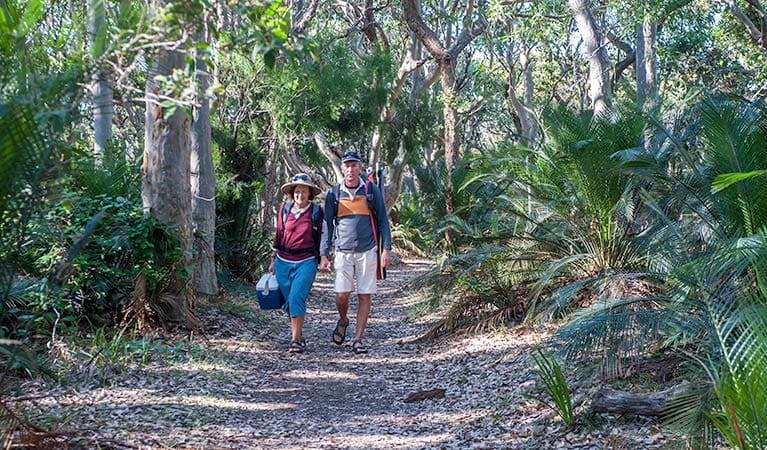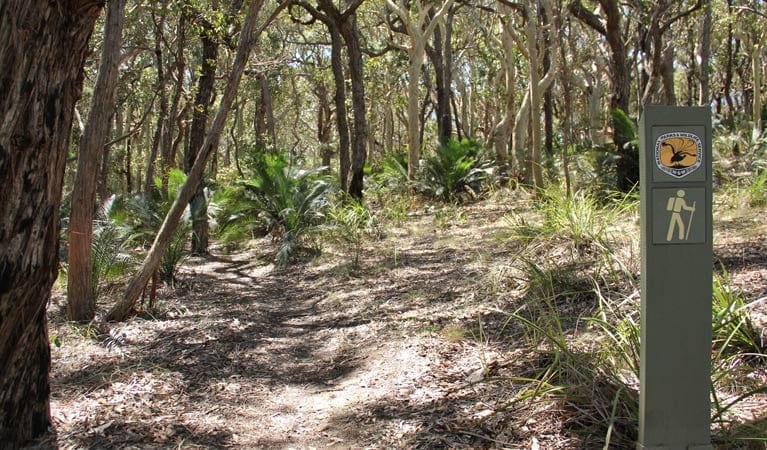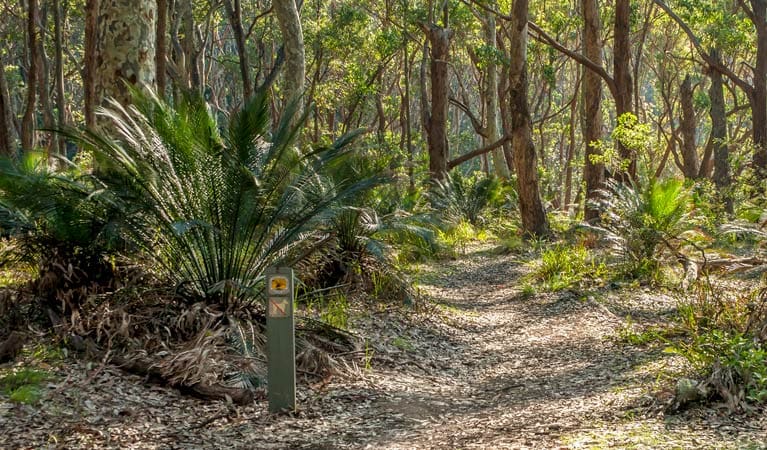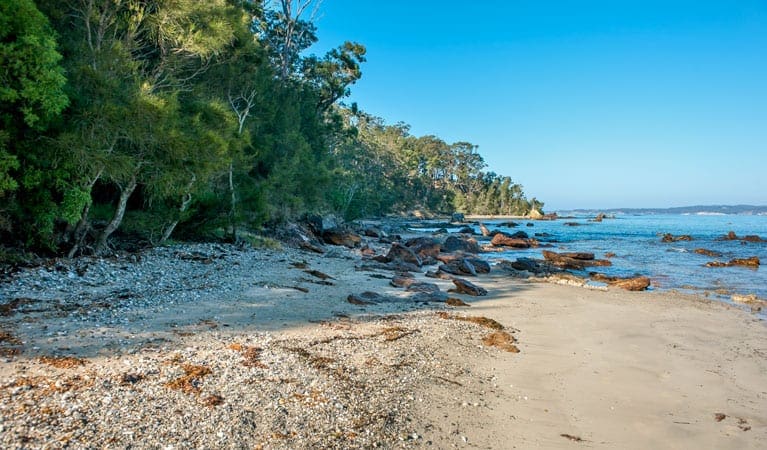Trail Fast Facts
Oaky Beach walking track is a 1.2km, grade 3 hike in Murramarang National Park, New South Wales. This hike typically takes 1 hour to complete.
Hike Overview
The Oaky Beach walking track in Murramarang National Park provides a delightful escape to a secluded beach paradise, ideal for those seeking an easy 1.2-kilometer (roundtrip) hike. This grade 3 track takes approximately 1 hour to complete and is located just north of Batemans Bay.
The adventure begins amidst towering lilly pilly trees, which offer a treat of edible pink berries during the warmer months. As you traverse a grassy clearing and a stand of she-oaks, keep your eyes peeled for native wildlife such as swamp wallabies and lyrebirds. The path then winds through a swamp gully, where you might be lucky enough to hear the call of the eastern whipbird before emerging onto the secluded beach.
Imagine yourself on a remote coastline, with a good chance of having the entire beach to yourself (except perhaps for some oystercatchers). Enjoy a refreshing swim in the cool waters, try your hand at fishing, or simply relax with a picnic, soaking in the beauty of this unspoiled natural haven.
Track Grade
Grade 3 (Moderate) - Walks for Most Fitness Levels: Grade 3 on the AWTGS represents moderate walking tracks. These are ideal for walkers with some fitness who are comfortable with some hills and uneven terrain. While suitable for most ages, some bushwalking experience is recommended to ensure a safe and enjoyable experience. Tracks may have short, steep hill sections, a rough surface, and many steps. The total distance of a Grade 3 walk can be up to 20 kilometers.
Tips
- It's a good idea to put sunscreen on before you set out and remember to take a hat and plenty of water.
- Remember to take your binoculars if you want to bird watch or whale watch.
- Strong rips may be present at Oaky Beach, so take care in the water and please supervise children at all times.
Map and GPX file
Max elevation: 52 m
Min elevation: 5 m
Total climbing: 57 m
Total descent: -57 m
Trailhead
Sorry, no records were found. Please adjust your search criteria and try again.
Sorry, unable to load the Maps API.
Getting there
Accessible by car, the Oaky Beach walking track is situated within the southern precinct of Murramarang National Park. To reach the trailhead, travelers can depart from the Princes Highway and turn onto Durras Road. After continuing for a while, turn right onto North Head Road and follow it for roughly 4 kilometers. You'll then see Old Coast Road on your left – be sure to check the weather conditions beforehand, as this road can become boggy after rainfall. Follow signage directing you to Oaky Beach, where you'll find parking available at the carpark.
Photo gallery
If you’ve got some great shots from this hike, I’d love to see them! Please upload your .jpg files here to help inspire other hikers and show off the beauty of the trail.
A quick note: Uploading your photos doesn’t mean you lose ownership. You’ll be credited for any photos you share, and you can request to have them removed at any time.
About the region
Murramarang National Park, a nature lover's paradise, stretches along 44 kilometers of dramatic coastline on the NSW south coast, near Batemans Bay. Here, visitors can camp under the shade of spotted gum trees that grow right down to the oceanfront, creating a stunning backdrop for a year-round escape. The park offers a variety of activities. Hike or bike along the trails, explore the cliffs and headlands, or relax on pristine beaches. Take a dip in the ocean, go surfing, or cast a fishing line for your dinner. Keep an eye out for eastern grey kangaroos and the abundant birdlife that call the park home.
The park is particularly famous for the multi-day Murramarang South Coast Walk, a spectacular 3-day adventure for experienced hikers. But there are options for all fitness levels. Explore the Durras Lake discovery trail, perfect for a family outing with children, or rent a canoe to paddle around the calm waters of Durras Lake. Whether you're looking for a day trip or a longer stay, Murramarang National Park has something for everyone. Choose from a variety of camping options, including caravan and motorhome sites with amenities, or book a cabin for a more comfortable stay.
Suggest an edit
Spotted a change on this trail? Maybe there are new features, the route has shifted, or the trail is permanently closed. Whatever the update, I’d love your input. Your feedback helps fellow hikers stay informed and ensures that our trail info stays fresh and reliable.
Similar trails nearby
Looking for things to do in Murramarang National Park or nearby? Try these similar hikes or bushwalks.
Let someone know
Adventure with Confidence: Register Your Trip Plans
Before you hit the trail, take a moment to fill out our trip intentions form. It’s a simple way to share important details about your hike with family or friends. If things don’t go as planned and you’re not back on time, they can easily notify emergency services, helping to ensure a quick response and reducing worry. Enjoy your outdoor adventure knowing that you’ve taken a smart step for your safety.
Gear to consider
What you carry in your pack will depend on the weather, terrain, time of year, type of adventure, and personal preferences. Having trouble deciding what gear’s right for you? My free planning, food and packing checklists provide an introduction to things your could consider (as well as the Ten Essentials) on your day, overnight and multi-day adventures. Customise your kit according to your personal needs, always considering safety first.
Explore Safe
While planning your hike, it’s important to check official government sources for updated information, temporary closures and trail access requirements. Before hitting the trail, check local weather and bushfire advice for planned burns and bushfire warnings and let someone know before you go. Plan ahead and hike safely.
Weather
Acknowledgement of Country
Trail Hiking Australia acknowledges the Traditional Owners of the lands on which we hike and pay respects to their Elders, past and present, and we acknowledge the First Nations people of other communities who may be here today.






